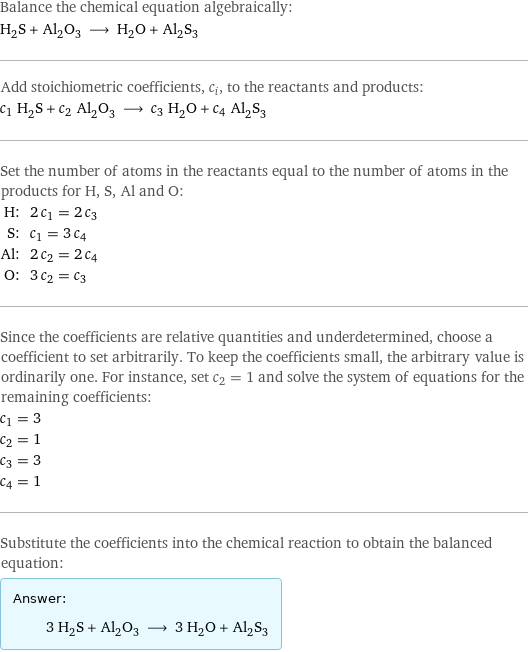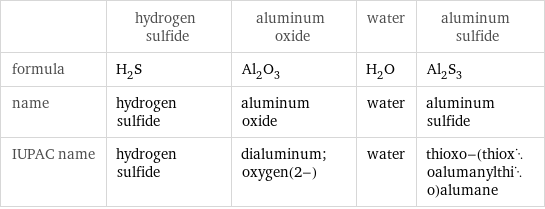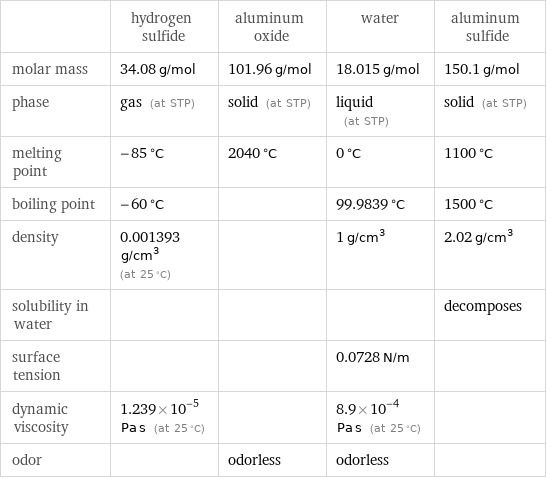Input interpretation

H_2S hydrogen sulfide + Al_2O_3 aluminum oxide ⟶ H_2O water + Al_2S_3 aluminum sulfide
Balanced equation

Balance the chemical equation algebraically: H_2S + Al_2O_3 ⟶ H_2O + Al_2S_3 Add stoichiometric coefficients, c_i, to the reactants and products: c_1 H_2S + c_2 Al_2O_3 ⟶ c_3 H_2O + c_4 Al_2S_3 Set the number of atoms in the reactants equal to the number of atoms in the products for H, S, Al and O: H: | 2 c_1 = 2 c_3 S: | c_1 = 3 c_4 Al: | 2 c_2 = 2 c_4 O: | 3 c_2 = c_3 Since the coefficients are relative quantities and underdetermined, choose a coefficient to set arbitrarily. To keep the coefficients small, the arbitrary value is ordinarily one. For instance, set c_2 = 1 and solve the system of equations for the remaining coefficients: c_1 = 3 c_2 = 1 c_3 = 3 c_4 = 1 Substitute the coefficients into the chemical reaction to obtain the balanced equation: Answer: | | 3 H_2S + Al_2O_3 ⟶ 3 H_2O + Al_2S_3
Structures

+ ⟶ +
Names

hydrogen sulfide + aluminum oxide ⟶ water + aluminum sulfide
Reaction thermodynamics
Enthalpy

| hydrogen sulfide | aluminum oxide | water | aluminum sulfide molecular enthalpy | -20.6 kJ/mol | -1676 kJ/mol | -285.8 kJ/mol | -724 kJ/mol total enthalpy | -61.8 kJ/mol | -1676 kJ/mol | -857.5 kJ/mol | -724 kJ/mol | H_initial = -1738 kJ/mol | | H_final = -1581 kJ/mol | ΔH_rxn^0 | -1581 kJ/mol - -1738 kJ/mol = 156.3 kJ/mol (endothermic) | | |
Equilibrium constant
![Construct the equilibrium constant, K, expression for: H_2S + Al_2O_3 ⟶ H_2O + Al_2S_3 Plan: • Balance the chemical equation. • Determine the stoichiometric numbers. • Assemble the activity expression for each chemical species. • Use the activity expressions to build the equilibrium constant expression. Write the balanced chemical equation: 3 H_2S + Al_2O_3 ⟶ 3 H_2O + Al_2S_3 Assign stoichiometric numbers, ν_i, using the stoichiometric coefficients, c_i, from the balanced chemical equation in the following manner: ν_i = -c_i for reactants and ν_i = c_i for products: chemical species | c_i | ν_i H_2S | 3 | -3 Al_2O_3 | 1 | -1 H_2O | 3 | 3 Al_2S_3 | 1 | 1 Assemble the activity expressions accounting for the state of matter and ν_i: chemical species | c_i | ν_i | activity expression H_2S | 3 | -3 | ([H2S])^(-3) Al_2O_3 | 1 | -1 | ([Al2O3])^(-1) H_2O | 3 | 3 | ([H2O])^3 Al_2S_3 | 1 | 1 | [Al2S3] The equilibrium constant symbol in the concentration basis is: K_c Mulitply the activity expressions to arrive at the K_c expression: Answer: | | K_c = ([H2S])^(-3) ([Al2O3])^(-1) ([H2O])^3 [Al2S3] = (([H2O])^3 [Al2S3])/(([H2S])^3 [Al2O3])](../image_source/79bd4736183f990758a01071f41f90d1.png)
Construct the equilibrium constant, K, expression for: H_2S + Al_2O_3 ⟶ H_2O + Al_2S_3 Plan: • Balance the chemical equation. • Determine the stoichiometric numbers. • Assemble the activity expression for each chemical species. • Use the activity expressions to build the equilibrium constant expression. Write the balanced chemical equation: 3 H_2S + Al_2O_3 ⟶ 3 H_2O + Al_2S_3 Assign stoichiometric numbers, ν_i, using the stoichiometric coefficients, c_i, from the balanced chemical equation in the following manner: ν_i = -c_i for reactants and ν_i = c_i for products: chemical species | c_i | ν_i H_2S | 3 | -3 Al_2O_3 | 1 | -1 H_2O | 3 | 3 Al_2S_3 | 1 | 1 Assemble the activity expressions accounting for the state of matter and ν_i: chemical species | c_i | ν_i | activity expression H_2S | 3 | -3 | ([H2S])^(-3) Al_2O_3 | 1 | -1 | ([Al2O3])^(-1) H_2O | 3 | 3 | ([H2O])^3 Al_2S_3 | 1 | 1 | [Al2S3] The equilibrium constant symbol in the concentration basis is: K_c Mulitply the activity expressions to arrive at the K_c expression: Answer: | | K_c = ([H2S])^(-3) ([Al2O3])^(-1) ([H2O])^3 [Al2S3] = (([H2O])^3 [Al2S3])/(([H2S])^3 [Al2O3])
Rate of reaction
![Construct the rate of reaction expression for: H_2S + Al_2O_3 ⟶ H_2O + Al_2S_3 Plan: • Balance the chemical equation. • Determine the stoichiometric numbers. • Assemble the rate term for each chemical species. • Write the rate of reaction expression. Write the balanced chemical equation: 3 H_2S + Al_2O_3 ⟶ 3 H_2O + Al_2S_3 Assign stoichiometric numbers, ν_i, using the stoichiometric coefficients, c_i, from the balanced chemical equation in the following manner: ν_i = -c_i for reactants and ν_i = c_i for products: chemical species | c_i | ν_i H_2S | 3 | -3 Al_2O_3 | 1 | -1 H_2O | 3 | 3 Al_2S_3 | 1 | 1 The rate term for each chemical species, B_i, is 1/ν_i(Δ[B_i])/(Δt) where [B_i] is the amount concentration and t is time: chemical species | c_i | ν_i | rate term H_2S | 3 | -3 | -1/3 (Δ[H2S])/(Δt) Al_2O_3 | 1 | -1 | -(Δ[Al2O3])/(Δt) H_2O | 3 | 3 | 1/3 (Δ[H2O])/(Δt) Al_2S_3 | 1 | 1 | (Δ[Al2S3])/(Δt) (for infinitesimal rate of change, replace Δ with d) Set the rate terms equal to each other to arrive at the rate expression: Answer: | | rate = -1/3 (Δ[H2S])/(Δt) = -(Δ[Al2O3])/(Δt) = 1/3 (Δ[H2O])/(Δt) = (Δ[Al2S3])/(Δt) (assuming constant volume and no accumulation of intermediates or side products)](../image_source/814c97419f97808e02abb00ee92c1494.png)
Construct the rate of reaction expression for: H_2S + Al_2O_3 ⟶ H_2O + Al_2S_3 Plan: • Balance the chemical equation. • Determine the stoichiometric numbers. • Assemble the rate term for each chemical species. • Write the rate of reaction expression. Write the balanced chemical equation: 3 H_2S + Al_2O_3 ⟶ 3 H_2O + Al_2S_3 Assign stoichiometric numbers, ν_i, using the stoichiometric coefficients, c_i, from the balanced chemical equation in the following manner: ν_i = -c_i for reactants and ν_i = c_i for products: chemical species | c_i | ν_i H_2S | 3 | -3 Al_2O_3 | 1 | -1 H_2O | 3 | 3 Al_2S_3 | 1 | 1 The rate term for each chemical species, B_i, is 1/ν_i(Δ[B_i])/(Δt) where [B_i] is the amount concentration and t is time: chemical species | c_i | ν_i | rate term H_2S | 3 | -3 | -1/3 (Δ[H2S])/(Δt) Al_2O_3 | 1 | -1 | -(Δ[Al2O3])/(Δt) H_2O | 3 | 3 | 1/3 (Δ[H2O])/(Δt) Al_2S_3 | 1 | 1 | (Δ[Al2S3])/(Δt) (for infinitesimal rate of change, replace Δ with d) Set the rate terms equal to each other to arrive at the rate expression: Answer: | | rate = -1/3 (Δ[H2S])/(Δt) = -(Δ[Al2O3])/(Δt) = 1/3 (Δ[H2O])/(Δt) = (Δ[Al2S3])/(Δt) (assuming constant volume and no accumulation of intermediates or side products)
Chemical names and formulas

| hydrogen sulfide | aluminum oxide | water | aluminum sulfide formula | H_2S | Al_2O_3 | H_2O | Al_2S_3 name | hydrogen sulfide | aluminum oxide | water | aluminum sulfide IUPAC name | hydrogen sulfide | dialuminum;oxygen(2-) | water | thioxo-(thioxoalumanylthio)alumane
Substance properties

| hydrogen sulfide | aluminum oxide | water | aluminum sulfide molar mass | 34.08 g/mol | 101.96 g/mol | 18.015 g/mol | 150.1 g/mol phase | gas (at STP) | solid (at STP) | liquid (at STP) | solid (at STP) melting point | -85 °C | 2040 °C | 0 °C | 1100 °C boiling point | -60 °C | | 99.9839 °C | 1500 °C density | 0.001393 g/cm^3 (at 25 °C) | | 1 g/cm^3 | 2.02 g/cm^3 solubility in water | | | | decomposes surface tension | | | 0.0728 N/m | dynamic viscosity | 1.239×10^-5 Pa s (at 25 °C) | | 8.9×10^-4 Pa s (at 25 °C) | odor | | odorless | odorless |
Units
